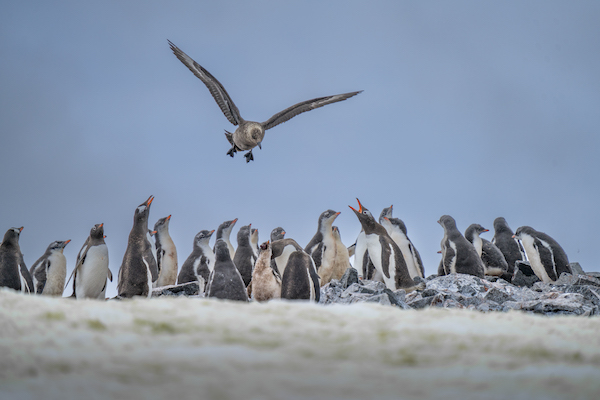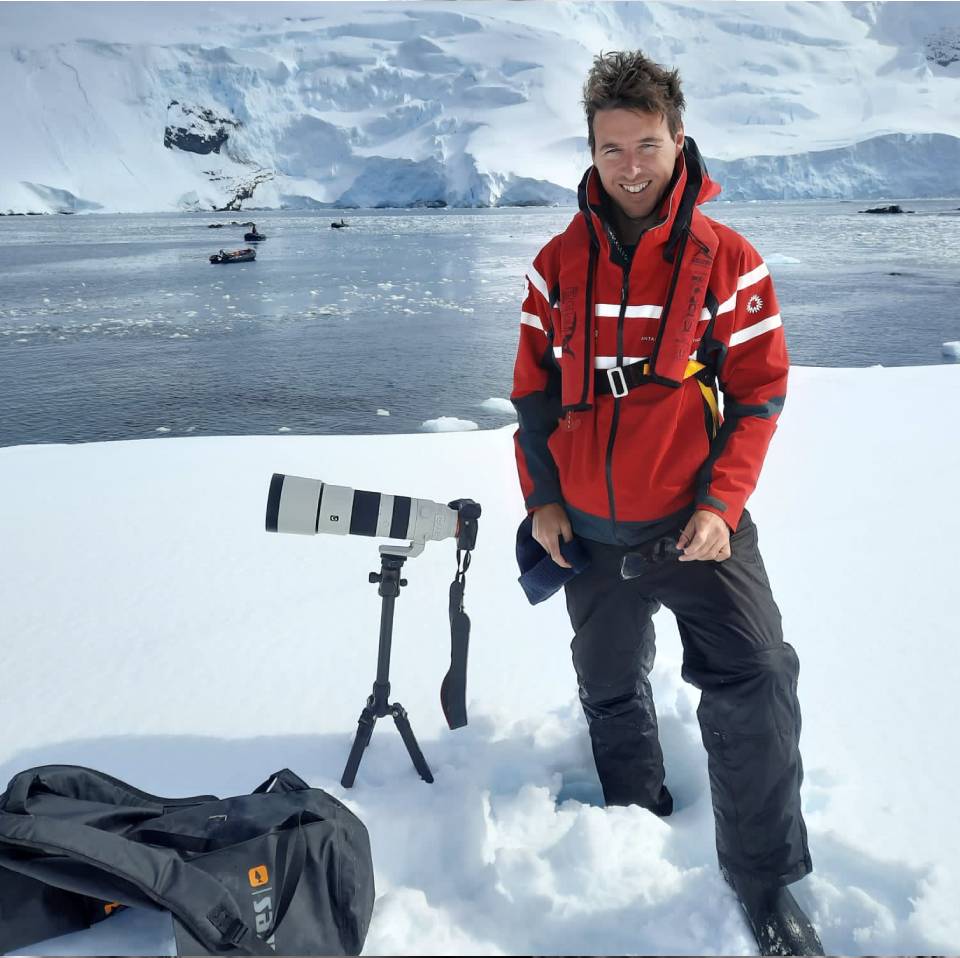Birdwatching in Antarctica offers an exciting opportunity for enthusiasts to see some of the most unique species in the world.
Every time I visit the White Continent I pack my binoculars first! I am a big bird watcher and Antarctica is such a treat for me.
While the continent is known for its extreme conditions, it’s also home to a variety of hardy seabirds that thrive in these icy waters.
What I love about the Antarctic landscape is that there is very little cover or vegetation for birds to hide in. This allows birdwatchers unusually clear views and photo opportunities!
In this article, we'll cover some rare species you might encounter, along with tips on where and how to find them during your Antarctic expedition.
Please note that I have left penguin species off this list. For a full list of penguin species you can see in Antarctica, click here.
1. The Snowy Sheathbill (Chionis albus)
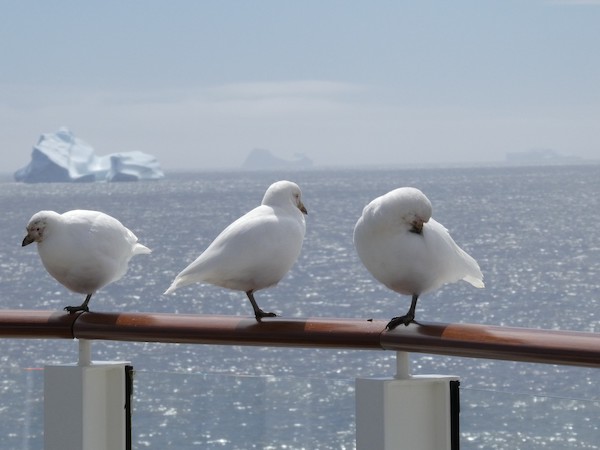
Where to Find Them:
Snowy Sheathbills are one of the few Antarctic birds not bound to the sea.
They’re often spotted near penguin colonies along theAntarctic Peninsula and on sub-Antarctic islands, where they forage for food and make their nests.
Many times I have witnessed these cheeky birds land on our ship and scavenge for food! They are quite confident birds and not easily startled.
Look for them on land rather than at sea; they're often seen scavenging on beaches, near penguin rookeries, and around research stations.
About the Species:
The Snowy Sheathbill is a small, stocky bird known for its all-white plumage, stout pink legs, and unique beak, which has a hard, horn-like sheath covering the base.
They have never been the prettiest bird in my eyes, but I do like their personality.
Unlike most Antarctic birds, sheathbills lack webbed feet, which is why they’re rarely seen in the water.
Opportunistic feeders, they play a role as “cleaners” of the Antarctic ecosystem, scavenging leftovers from penguins, seals, and even human food waste. Their adaptability allows them to thrive in a landscape with limited food sources, making them one of Antarctica's hardiest birds.
When to See Them:
Snowy Sheathbills are best observed during the Antarctic summer (November to February), especially around penguin breeding colonies where they find ample feeding opportunities. Their presence near these colonies also provides birdwatchers a chance to witness the interactions between different species in Antarctica’s unique ecosystem.
2. The Antarctic Petrel (Thalassoica antarctica)
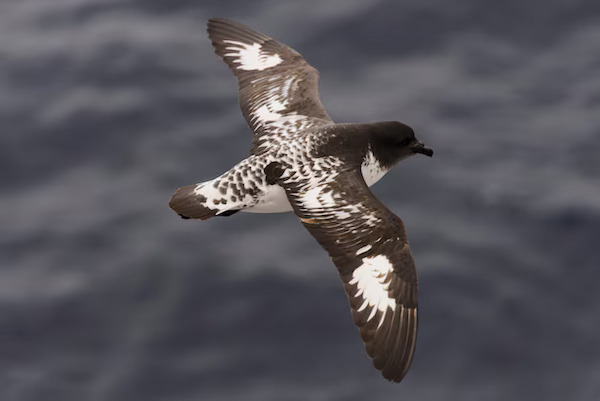
Where to Find Them:
Antarctic Petrels are commonly found along the coastline, especially around the Roass Sea and East Antarctica.
Some of the best places to spot them include near ice floes and cliffs where they breed.
About the Species:
With their distinctive brown-and-white patterned wings, Antarctic Petrels are easy to recognize.
These seabirds spend most of their lives on the wing, using the wind to glide across the sea as they search for krill and fish.
During the breeding season, they nest in dense colonies on cliff faces and rocky outcrops that are often snow-free, giving them a unique vantage point over the open ocean.
When to See Them:
The best time to see Antarctic Petrels is between November and March, during their breeding season. The warmer months also coincide with increased marine life, providing ample food sources for the birds.
3. The South Polar Skua (Stercorarius maccormicki)
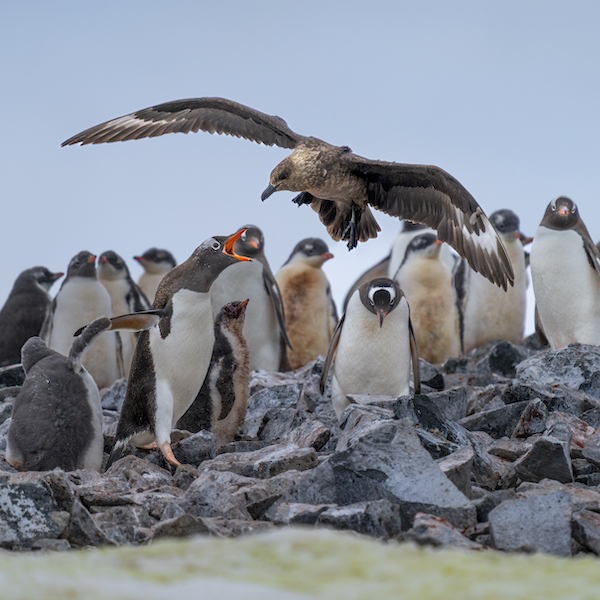
Where to Find Them:
South Polar Skuas are found all over the Antarctic coastline and can often be seen near penguin colonies.
They’re particularly common around the Antarctic Peninsula, where they scavenge for food.
About the Species:
South Polar Skuas have a bit of a reputation among birdwatchers and researchers alike.
With their powerful build and aggressive hunting style, they’re known to prey on penguin chicks and eggs, which makes them frequent visitors to penguin colonies.
Although not always pleasant to witness, I have got some great pictures of these large birds hovering above angry penguins trying to protect their eggs and their young.
They are mottled brown in color and have a stocky body, making them easy to distinguish from other seabirds.
When to See Them:
Skuas are most active during the summer months, from November to February, which coincides with the penguin breeding season.
Their presence at penguin colonies is unmistakable and offers a glimpse into the harsher side of the Antarctic ecosystem.
4. The Snow Petrel (Pagodroma nivea)
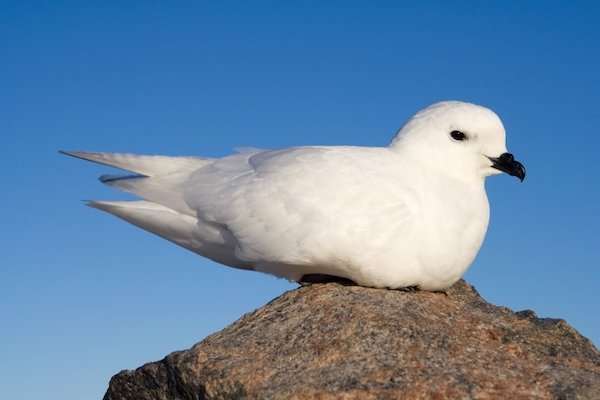
Where to Find Them:
One of my favourite Antarctic birds to photograph, Snow Petrels have a broad distribution across Antarctica and are frequently spotted near icebergs, cliffs, and ice-covered waters.
Look for them around the Ross Ice Shelf or other major ice formations along the coast. They are a joy to watch as they skim just above the waves!
About the Species:
The Snow Petrel is one of the few all-white birds in the Antarctic, making it especially striking against the blue ice.
It’s relatively small, with a wingspan of about 80-95 cm, and it’s known for its graceful flying. These birds nest on cliffs and crevices, where they lay a single egg each season.
When to See Them:
They are visible year-round but are more active during the breeding season, from November to January.
Snow Petrels are well-adapted to the freezing conditions, and their striking appearance makes them popular among photographers (including me!).
5. The Black-Browed Albatross (Thalassarche melanophris)
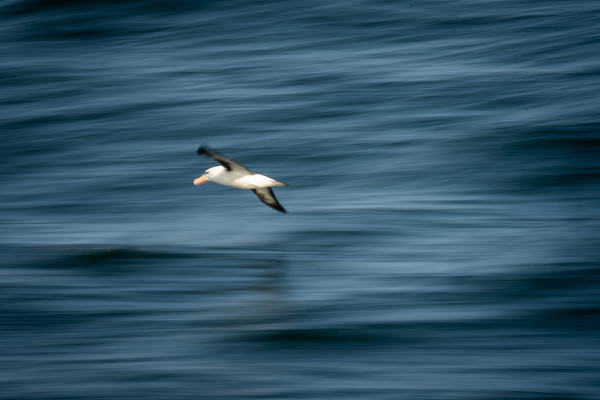
Where to Find Them:
While they don’t breed in Antarctica proper, Black-Browed Albatrosses are commonly seen in the Southern Ocean and around the South Shetland Islands and South Georgia, particularly on cruises that include these regions.
Saying that, I have seen plenty of Black-Browed Albatross while crossing the Drake Passage (and the occasional Wandering Albatross), so always keep your eyes peeled.
About the Species:
Black-Browed Albatrosses are very large birds, with a wingspan that can exceed 2 meters (6.5 feet). However, it is only when they come close to the ship that you can truly appreciate their enormous wingspan.
They are distinguished by their dark “eyebrows,” which contrast with their white head, and their graceful, soaring flight over the ocean.
These birds are masterful gliders and an absolute joy to watch from the ship. They can stay in the air for years at a time which is almost unthinkable!
When to See Them:
Black-Browed Albatrosses are often sighted during the Antarctic summer as they feed in the nutrient-rich waters of the Southern Ocean.
They’re frequently seen from the decks of expedition ships, particularly in choppy waters where they come to feast on fish stirred up by the waves.
6. The Blue-Eyed Shag (Phalacrocorax atriceps)
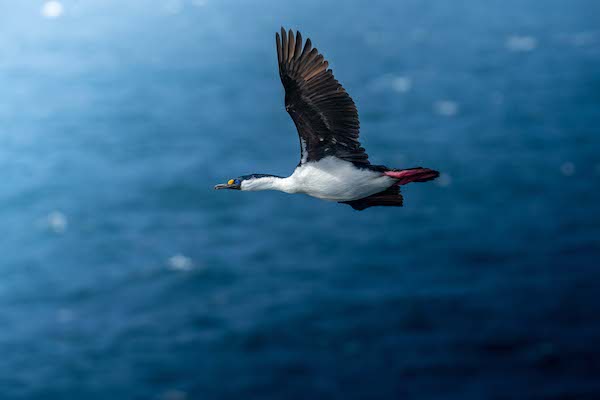
Where to Find Them:
Blue-Eyed Shags are a firm favorite of mine. Also known as Imperial Shags, these blue-eyed marvels are found around the Antarctic Peninsula and nearby islands.
Look for them on rocky cliffs and inshore waters, often perched on rocks with their wings outstretched to dry.
About the Species:
This striking bird has a unique look with its bright blue eyes and a yellow, fleshy patch at the base of its beak.
As one of the few types of cormorants to live so far south, Blue-Eyed Shags are excellent divers and rely on fish as their main food source.
They often nest in colonies, so spotting them is easier when they're gathered in groups.
When to See Them:
They are most visible in December and January during their breeding season, and they’re particularly active during low tide when feeding is easier.
Tips for Birdwatching in Antarctica
Birdwatching in Antarctica requires some preparation, as conditions can be challenging:
- Bring Quality Binoculars and a Camera: Since many birds can be seen from a distance, having a good pair of binoculars helps you enjoy details without getting too close. A camera with a zoom lens is ideal for capturing clear shots.
- Dress Warmly and in Layers: Antarctic weather is unpredictable, even in summer. Wearing layers and waterproof outer gear helps you stay comfortable during long periods outside.
- Choose the Right Time of Year: November through February is the best period for birdwatching, with plenty of marine life activity. This also aligns with the peak tourist season for Antarctic cruises.
- Speak to your guides: All expedition cruises to Antarctica include naturalist guides and ornithologists who lead guided birdwatching tours and offer insights about the species you encounter.
- Respect the Wildlife: Antarctic bird species are protected by the Antarctic Treaty, so it’s essential to maintain a respectful distance and follow the guidelines provided by your guides.
For more information on birds you can see in Antarctica, click here.

